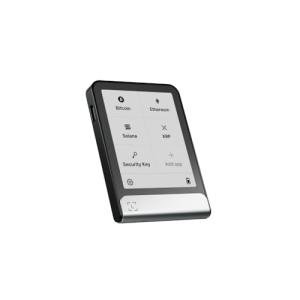What is the Ledger Flex
Ledger Flex is a hardware wallet made by Ledger (a French company known for its Ledger Nano line, among others). It is designed to combine security and convenience by including features such as an E Ink touchscreen, Bluetooth, and compatibility with Ledger’s software ecosystem.
Key features include:
-
A 2.84-inch E Ink® touchscreen (monochrome, 16-grayscale) for reviewing and approving transactions directly on the device.
-
A Secure Element chip to store private keys offline and provide strong security isolation.
-
Connectivity via USB-C and Bluetooth so it can be used with desktops, smartphones (both Android & iOS) etc.
-
Over 15,000 supported cryptocurrencies & tokens.
-
Inclusion of Ledger Recovery Key, a private backup mechanism for the Secret Recovery Phrase (seed phrase) so you can restore access if you lose or damage the device.
-
Customisable/display options: you can use your own photo or NFT for the device's lock screen.
How it works (Security & UX)
The idea is that Ledger Flex acts as a self-custody, cold storage wallet: your private keys never leave the secure chip inside the device. When you want to make a transaction (send crypto, interact with smart contracts, etc.), you initiate it via software (e.g. Ledger Live on your phone or PC), then you review and confirm on the device itself using the touchscreen. This ensures you see exactly what you are signing.
Some security design elements:
-
PIN protection: you set a PIN, required to access the device or perform operations.
-
If someone enters wrong PIN multiple times, the device resets to factory settings, wiping sensitive info.
-
The Secure Element is certified. Ledger uses its own OS (Ledger OS) for firmware, transaction checking etc.
-
The Recovery Key adds an extra backup mechanism. How exactly this works (how it's stored, how secure the backup is) is important to check.
User-experience benefits:
-
Having a screen rather than using buttons and small displays makes reviewing transactions/workflow easier, more intuitive. Signatures are clearer.
-
Since it’s wearable / portable, with Bluetooth + USB-C, you can use it with mobile devices which is helpful for DeFi/NFT etc.
-
Customisable appearance adds a personal touch.
Pros & Advantages
Here are some of the strong points of the Flex:
-
Improved usability: The touchscreen allows more transparent transaction review than earlier Ledger models (which had buttons and small displays). Less of a “guess what this says” situation.
-
Security: Because of the Secure Element, offline storage of private keys, and PIN protection. Also, the inclusion of a Recovery Key makes losing the device less disastrous.
-
Wide coin & token support: As Ledger claims, thousands of coins/tokens are supported, which is essential if you hold a varied portfolio.
-
Portability & connectivity: Bluetooth + USB-C means you can use it with various platforms. Good for people working with crypto on the go.
-
Brand & ecosystem: Ledger has an established user base, software (Ledger Live), firmware updates, third-party integrations etc. Having this ecosystem helps with long-term reliability.
Cons & Trade-Offs
No product is perfect. Some of the trade-offs and potential downsides:
-
Price: Naturally, adding a touchscreen + more features will cost more than entry level models. For some users who only want to store / send a few popular coins, a simpler device may suffice at lower cost.
-
Complexity / attack surface: More features (Bluetooth, screen, etc.) can introduce more systems that need securing. Bluetooth in particular is often considered less secure than a purely wired or completely offline device. Even though Ledger likely mitigates risk, any wireless connection can introduce more risk.
-
Battery life: Using Bluetooth, screen etc. consumes power. The device will need charging. As with any battery-powered hardware wallet, long periods idle may drain battery or degrade battery over time.
-
Recovery key concerns & trade-offs: While offering an easier backup is good, users who are very conservative might prefer backup methods that give them maximum control (e.g. scratch cards, offline paper, etc.). Dependence on any backup service or features increases complexity.
-
Trust: As with any hardware wallet, you're placing trust in the manufacturer’s firmware, supply chain, and the security of remote / local software that interacts with it. If there are vulnerabilities in the software or hardware, they can be exploited.
Comparison with Other Ledger Devices
How Ledger Flex fits among Ledger’s offerings:
| Device | Key Differences compared to Flex |
|---|---|
| Ledger Nano S Plus / Nano X | These have no (or minimal) screens (or non-touch, smaller displays), rely more on buttons. Nano X adds Bluetooth etc. But Flex’s touchscreen gives more clarity. Some Nano devices might be cheaper. Flex sits at a more premium usability point. |
| Ledger Stax | Also has a curved E Ink touchscreen, more premium build / design. The Stax is more expensive and aimed at people who want both design & function. Flex is simpler visually but still adds touch + modern screen. |
| Entry-level Ledger devices | For people who only need basic storage and occasional sending, older simpler devices work. But they might be less convenient when dealing with many transactions or complicated smart contract interactions. |
Security Considerations & Best Practices
To make the most out of a Ledger Flex (or any hardware wallet), some things users should do / be aware of:
-
Always buy from official Ledger website or authorised reseller. Avoid used devices or devices of unknown provenance.
-
Keep firmware up to date. Security patches are important.
-
Don’t share your Secret Recovery Phrase / seed phrase. Ledger will never ask for it. Beware of phishing.
-
Use the Recovery Key backup safely: store it securely offline, in a way resistant to physical damage / loss.
-
Use a strong PIN and don’t reveal it.
-
When reviewing transactions on the touchscreen, take time to verify all details (address, amount, fees, smart contract operations) — don’t just tap through.
-
Store the device in a safe place. Even if the device is stolen, PIN will protect but might allow attempts to tamper.
Use cases: Who is Ledger Flex good for
-
Someone who holds a moderate to large crypto portfolio and wants more usability / visibility in transactions.
-
People active in DeFi / NFTs who need to interact with contracts and want clearer transaction signing.
-
Users who want portable but secure access (connect via phone etc.).
-
Users who prefer an integrated ecosystem (Ledger Live etc.).
It might be overkill for someone who simply holds a small amount, only uses Bitcoin or major coins, and rarely moves funds — for them a simpler hardware wallet might suffice.
Conclusion
Ledger Flex represents a step forward for hardware crypto wallets in usability, bringing a touchscreen interface plus modern backup features while aiming to maintain high security standards. It strikes a balance between convenience and safety. However, as with any tool for security, its effectiveness depends greatly on how carefully the user handles recovery, verifies firmware/software authenticity, and follows best practices.
Ledger Flex - Experience a Secure E Ink Touchscreen Crypto Wallet. (Graphite)
Product information
Product Review Score
4.3 out of 5 stars
180 reviews


